Impact of Social Media on Consumer Behavior: A TESCO Analysis
VerifiedAdded on 2020/02/05
|7
|1451
|154
Homework Assignment
AI Summary
This assignment analyzes the impact of social media on consumer behavior, specifically focusing on the case of TESCO. It begins with a reference list of relevant academic sources. The core of the assignment presents a survey with ten questions designed to gauge the influence of social media on TESCO's consumers. The questions cover various aspects, including the positive impact of social media, its role in future generations, its effect on market growth, its ability to attract new consumers, and its impact on brand reputation. The survey also explores how negative consumer views on social media affect TESCO, the company's ability to build strong consumer relationships, the use of social media for product and service awareness, its role in understanding consumer behavior, and its utility in adapting products and services to consumer needs. The assignment aims to provide a comprehensive understanding of how social media shapes consumer behavior and its implications for TESCO's marketing strategies and overall business performance. The survey results provide valuable insights into consumer perceptions and the effectiveness of social media engagement.
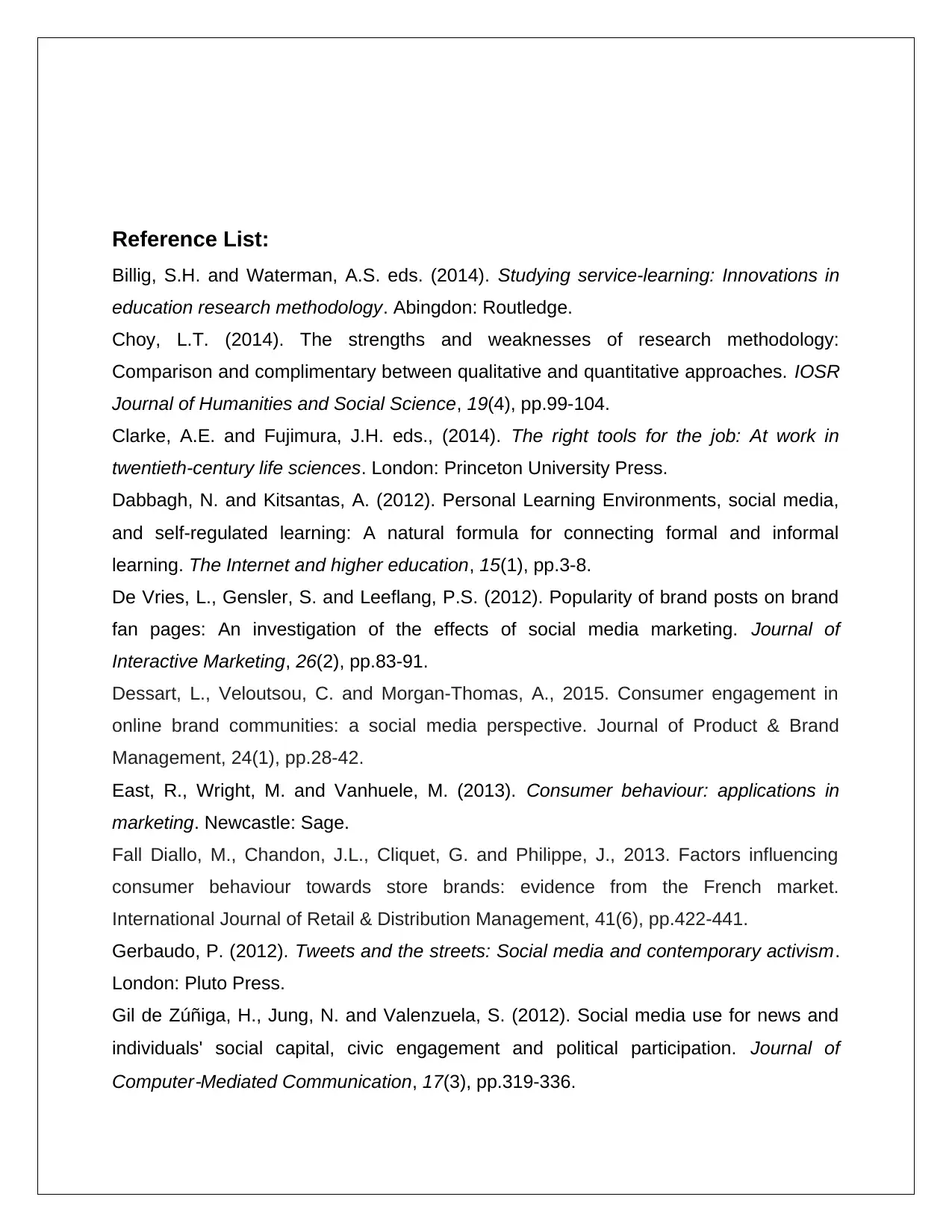
Reference List:
Billig, S.H. and Waterman, A.S. eds. (2014). Studying service-learning: Innovations in
education research methodology. Abingdon: Routledge.
Choy, L.T. (2014). The strengths and weaknesses of research methodology:
Comparison and complimentary between qualitative and quantitative approaches. IOSR
Journal of Humanities and Social Science, 19(4), pp.99-104.
Clarke, A.E. and Fujimura, J.H. eds., (2014). The right tools for the job: At work in
twentieth-century life sciences. London: Princeton University Press.
Dabbagh, N. and Kitsantas, A. (2012). Personal Learning Environments, social media,
and self-regulated learning: A natural formula for connecting formal and informal
learning. The Internet and higher education, 15(1), pp.3-8.
De Vries, L., Gensler, S. and Leeflang, P.S. (2012). Popularity of brand posts on brand
fan pages: An investigation of the effects of social media marketing. Journal of
Interactive Marketing, 26(2), pp.83-91.
Dessart, L., Veloutsou, C. and Morgan-Thomas, A., 2015. Consumer engagement in
online brand communities: a social media perspective. Journal of Product & Brand
Management, 24(1), pp.28-42.
East, R., Wright, M. and Vanhuele, M. (2013). Consumer behaviour: applications in
marketing. Newcastle: Sage.
Fall Diallo, M., Chandon, J.L., Cliquet, G. and Philippe, J., 2013. Factors influencing
consumer behaviour towards store brands: evidence from the French market.
International Journal of Retail & Distribution Management, 41(6), pp.422-441.
Gerbaudo, P. (2012). Tweets and the streets: Social media and contemporary activism.
London: Pluto Press.
Gil de Zúñiga, H., Jung, N. and Valenzuela, S. (2012). Social media use for news and
individuals' social capital, civic engagement and political participation. Journal of
Computer
‐Mediated Communication, 17(3), pp.319-336.
Billig, S.H. and Waterman, A.S. eds. (2014). Studying service-learning: Innovations in
education research methodology. Abingdon: Routledge.
Choy, L.T. (2014). The strengths and weaknesses of research methodology:
Comparison and complimentary between qualitative and quantitative approaches. IOSR
Journal of Humanities and Social Science, 19(4), pp.99-104.
Clarke, A.E. and Fujimura, J.H. eds., (2014). The right tools for the job: At work in
twentieth-century life sciences. London: Princeton University Press.
Dabbagh, N. and Kitsantas, A. (2012). Personal Learning Environments, social media,
and self-regulated learning: A natural formula for connecting formal and informal
learning. The Internet and higher education, 15(1), pp.3-8.
De Vries, L., Gensler, S. and Leeflang, P.S. (2012). Popularity of brand posts on brand
fan pages: An investigation of the effects of social media marketing. Journal of
Interactive Marketing, 26(2), pp.83-91.
Dessart, L., Veloutsou, C. and Morgan-Thomas, A., 2015. Consumer engagement in
online brand communities: a social media perspective. Journal of Product & Brand
Management, 24(1), pp.28-42.
East, R., Wright, M. and Vanhuele, M. (2013). Consumer behaviour: applications in
marketing. Newcastle: Sage.
Fall Diallo, M., Chandon, J.L., Cliquet, G. and Philippe, J., 2013. Factors influencing
consumer behaviour towards store brands: evidence from the French market.
International Journal of Retail & Distribution Management, 41(6), pp.422-441.
Gerbaudo, P. (2012). Tweets and the streets: Social media and contemporary activism.
London: Pluto Press.
Gil de Zúñiga, H., Jung, N. and Valenzuela, S. (2012). Social media use for news and
individuals' social capital, civic engagement and political participation. Journal of
Computer
‐Mediated Communication, 17(3), pp.319-336.
Paraphrase This Document
Need a fresh take? Get an instant paraphrase of this document with our AI Paraphraser
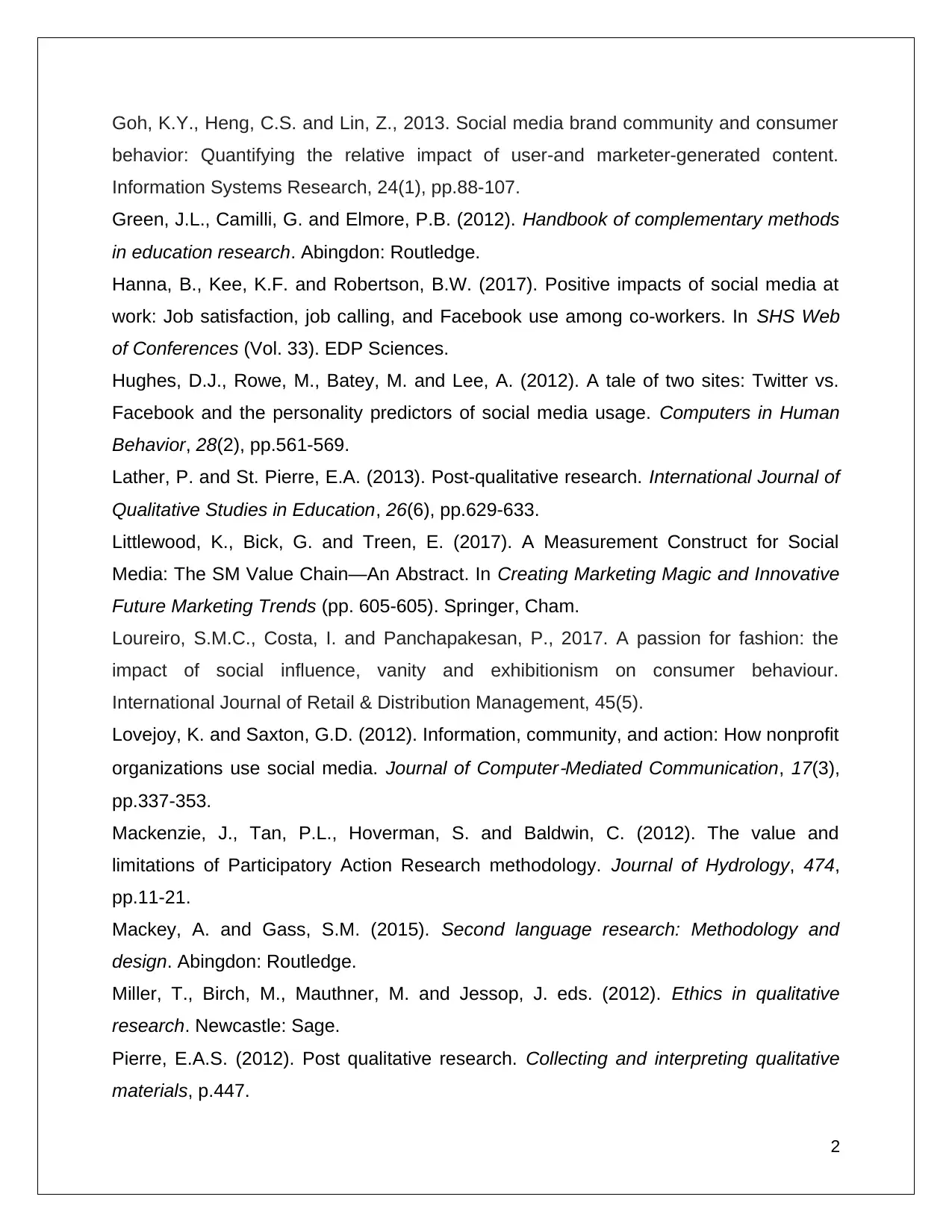
Goh, K.Y., Heng, C.S. and Lin, Z., 2013. Social media brand community and consumer
behavior: Quantifying the relative impact of user-and marketer-generated content.
Information Systems Research, 24(1), pp.88-107.
Green, J.L., Camilli, G. and Elmore, P.B. (2012). Handbook of complementary methods
in education research. Abingdon: Routledge.
Hanna, B., Kee, K.F. and Robertson, B.W. (2017). Positive impacts of social media at
work: Job satisfaction, job calling, and Facebook use among co-workers. In SHS Web
of Conferences (Vol. 33). EDP Sciences.
Hughes, D.J., Rowe, M., Batey, M. and Lee, A. (2012). A tale of two sites: Twitter vs.
Facebook and the personality predictors of social media usage. Computers in Human
Behavior, 28(2), pp.561-569.
Lather, P. and St. Pierre, E.A. (2013). Post-qualitative research. International Journal of
Qualitative Studies in Education, 26(6), pp.629-633.
Littlewood, K., Bick, G. and Treen, E. (2017). A Measurement Construct for Social
Media: The SM Value Chain—An Abstract. In Creating Marketing Magic and Innovative
Future Marketing Trends (pp. 605-605). Springer, Cham.
Loureiro, S.M.C., Costa, I. and Panchapakesan, P., 2017. A passion for fashion: the
impact of social influence, vanity and exhibitionism on consumer behaviour.
International Journal of Retail & Distribution Management, 45(5).
Lovejoy, K. and Saxton, G.D. (2012). Information, community, and action: How nonprofit
organizations use social media. Journal of Computer
‐Mediated Communication, 17(3),
pp.337-353.
Mackenzie, J., Tan, P.L., Hoverman, S. and Baldwin, C. (2012). The value and
limitations of Participatory Action Research methodology. Journal of Hydrology, 474,
pp.11-21.
Mackey, A. and Gass, S.M. (2015). Second language research: Methodology and
design. Abingdon: Routledge.
Miller, T., Birch, M., Mauthner, M. and Jessop, J. eds. (2012). Ethics in qualitative
research. Newcastle: Sage.
Pierre, E.A.S. (2012). Post qualitative research. Collecting and interpreting qualitative
materials, p.447.
2
behavior: Quantifying the relative impact of user-and marketer-generated content.
Information Systems Research, 24(1), pp.88-107.
Green, J.L., Camilli, G. and Elmore, P.B. (2012). Handbook of complementary methods
in education research. Abingdon: Routledge.
Hanna, B., Kee, K.F. and Robertson, B.W. (2017). Positive impacts of social media at
work: Job satisfaction, job calling, and Facebook use among co-workers. In SHS Web
of Conferences (Vol. 33). EDP Sciences.
Hughes, D.J., Rowe, M., Batey, M. and Lee, A. (2012). A tale of two sites: Twitter vs.
Facebook and the personality predictors of social media usage. Computers in Human
Behavior, 28(2), pp.561-569.
Lather, P. and St. Pierre, E.A. (2013). Post-qualitative research. International Journal of
Qualitative Studies in Education, 26(6), pp.629-633.
Littlewood, K., Bick, G. and Treen, E. (2017). A Measurement Construct for Social
Media: The SM Value Chain—An Abstract. In Creating Marketing Magic and Innovative
Future Marketing Trends (pp. 605-605). Springer, Cham.
Loureiro, S.M.C., Costa, I. and Panchapakesan, P., 2017. A passion for fashion: the
impact of social influence, vanity and exhibitionism on consumer behaviour.
International Journal of Retail & Distribution Management, 45(5).
Lovejoy, K. and Saxton, G.D. (2012). Information, community, and action: How nonprofit
organizations use social media. Journal of Computer
‐Mediated Communication, 17(3),
pp.337-353.
Mackenzie, J., Tan, P.L., Hoverman, S. and Baldwin, C. (2012). The value and
limitations of Participatory Action Research methodology. Journal of Hydrology, 474,
pp.11-21.
Mackey, A. and Gass, S.M. (2015). Second language research: Methodology and
design. Abingdon: Routledge.
Miller, T., Birch, M., Mauthner, M. and Jessop, J. eds. (2012). Ethics in qualitative
research. Newcastle: Sage.
Pierre, E.A.S. (2012). Post qualitative research. Collecting and interpreting qualitative
materials, p.447.
2
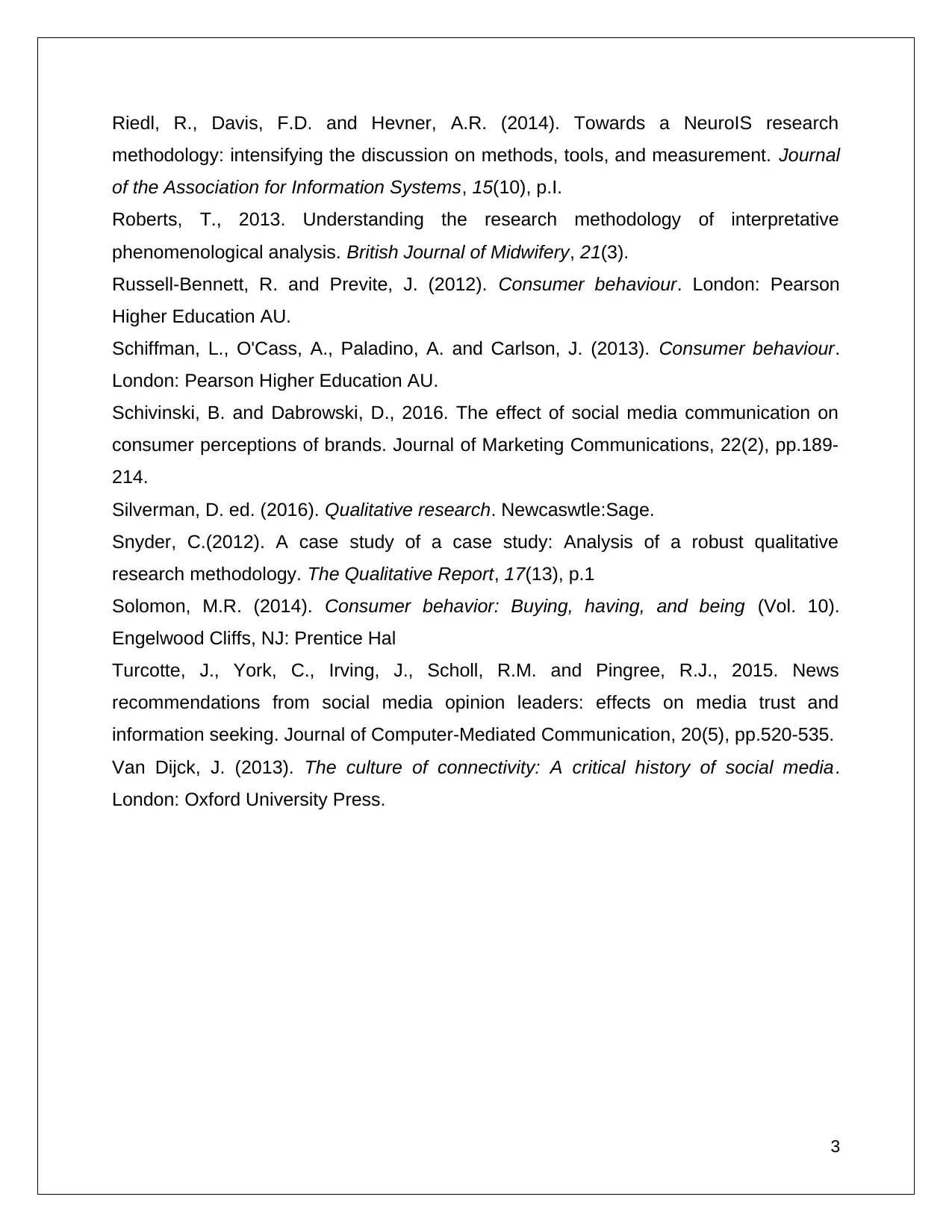
Riedl, R., Davis, F.D. and Hevner, A.R. (2014). Towards a NeuroIS research
methodology: intensifying the discussion on methods, tools, and measurement. Journal
of the Association for Information Systems, 15(10), p.I.
Roberts, T., 2013. Understanding the research methodology of interpretative
phenomenological analysis. British Journal of Midwifery, 21(3).
Russell-Bennett, R. and Previte, J. (2012). Consumer behaviour. London: Pearson
Higher Education AU.
Schiffman, L., O'Cass, A., Paladino, A. and Carlson, J. (2013). Consumer behaviour.
London: Pearson Higher Education AU.
Schivinski, B. and Dabrowski, D., 2016. The effect of social media communication on
consumer perceptions of brands. Journal of Marketing Communications, 22(2), pp.189-
214.
Silverman, D. ed. (2016). Qualitative research. Newcaswtle:Sage.
Snyder, C.(2012). A case study of a case study: Analysis of a robust qualitative
research methodology. The Qualitative Report, 17(13), p.1
Solomon, M.R. (2014). Consumer behavior: Buying, having, and being (Vol. 10).
Engelwood Cliffs, NJ: Prentice Hal
Turcotte, J., York, C., Irving, J., Scholl, R.M. and Pingree, R.J., 2015. News
recommendations from social media opinion leaders: effects on media trust and
information seeking. Journal of Computer‐Mediated Communication, 20(5), pp.520-535.
Van Dijck, J. (2013). The culture of connectivity: A critical history of social media.
London: Oxford University Press.
3
methodology: intensifying the discussion on methods, tools, and measurement. Journal
of the Association for Information Systems, 15(10), p.I.
Roberts, T., 2013. Understanding the research methodology of interpretative
phenomenological analysis. British Journal of Midwifery, 21(3).
Russell-Bennett, R. and Previte, J. (2012). Consumer behaviour. London: Pearson
Higher Education AU.
Schiffman, L., O'Cass, A., Paladino, A. and Carlson, J. (2013). Consumer behaviour.
London: Pearson Higher Education AU.
Schivinski, B. and Dabrowski, D., 2016. The effect of social media communication on
consumer perceptions of brands. Journal of Marketing Communications, 22(2), pp.189-
214.
Silverman, D. ed. (2016). Qualitative research. Newcaswtle:Sage.
Snyder, C.(2012). A case study of a case study: Analysis of a robust qualitative
research methodology. The Qualitative Report, 17(13), p.1
Solomon, M.R. (2014). Consumer behavior: Buying, having, and being (Vol. 10).
Engelwood Cliffs, NJ: Prentice Hal
Turcotte, J., York, C., Irving, J., Scholl, R.M. and Pingree, R.J., 2015. News
recommendations from social media opinion leaders: effects on media trust and
information seeking. Journal of Computer‐Mediated Communication, 20(5), pp.520-535.
Van Dijck, J. (2013). The culture of connectivity: A critical history of social media.
London: Oxford University Press.
3
⊘ This is a preview!⊘
Do you want full access?
Subscribe today to unlock all pages.

Trusted by 1+ million students worldwide
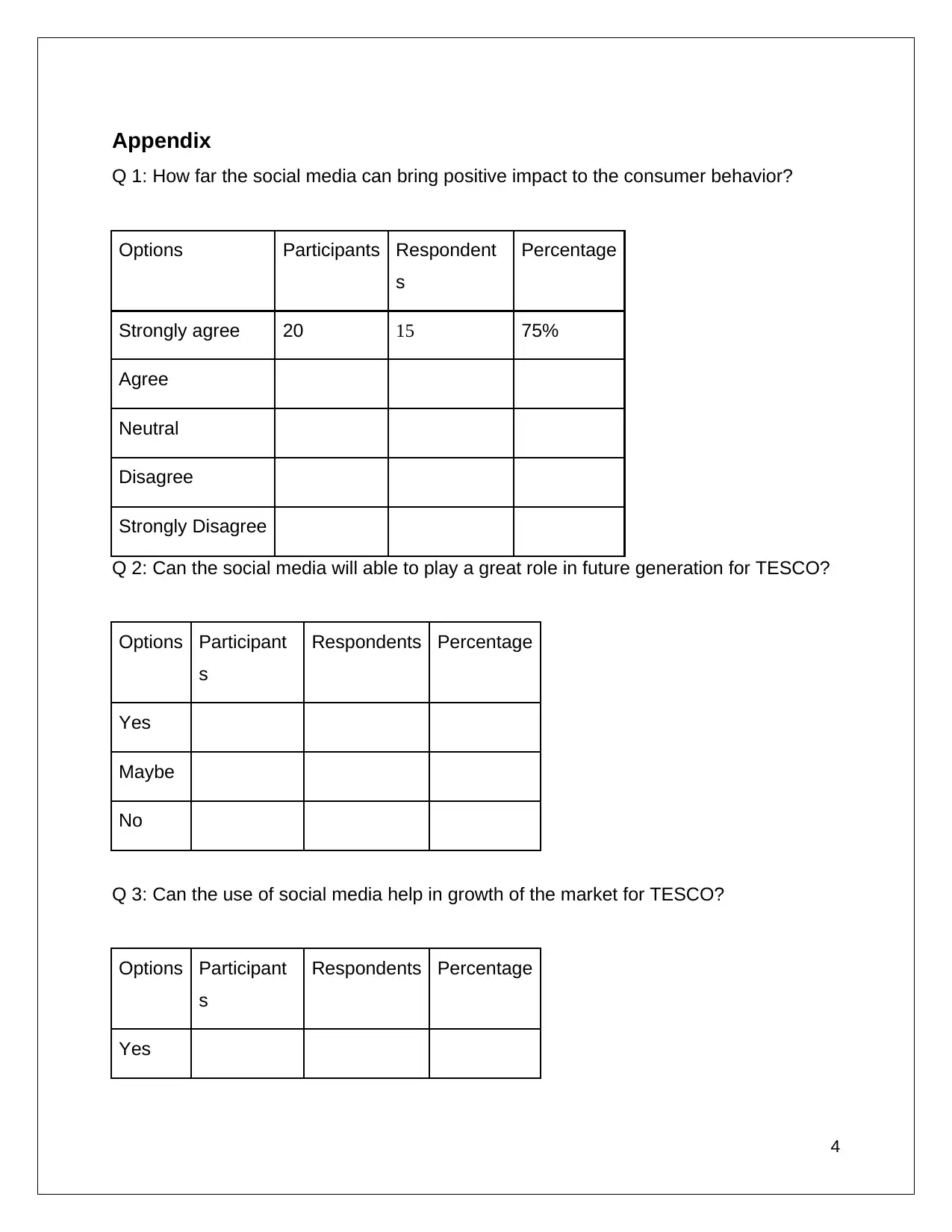
Appendix
Q 1: How far the social media can bring positive impact to the consumer behavior?
Options Participants Respondent
s
Percentage
Strongly agree 20 15 75%
Agree
Neutral
Disagree
Strongly Disagree
Q 2: Can the social media will able to play a great role in future generation for TESCO?
Options Participant
s
Respondents Percentage
Yes
Maybe
No
Q 3: Can the use of social media help in growth of the market for TESCO?
Options Participant
s
Respondents Percentage
Yes
4
Q 1: How far the social media can bring positive impact to the consumer behavior?
Options Participants Respondent
s
Percentage
Strongly agree 20 15 75%
Agree
Neutral
Disagree
Strongly Disagree
Q 2: Can the social media will able to play a great role in future generation for TESCO?
Options Participant
s
Respondents Percentage
Yes
Maybe
No
Q 3: Can the use of social media help in growth of the market for TESCO?
Options Participant
s
Respondents Percentage
Yes
4
Paraphrase This Document
Need a fresh take? Get an instant paraphrase of this document with our AI Paraphraser
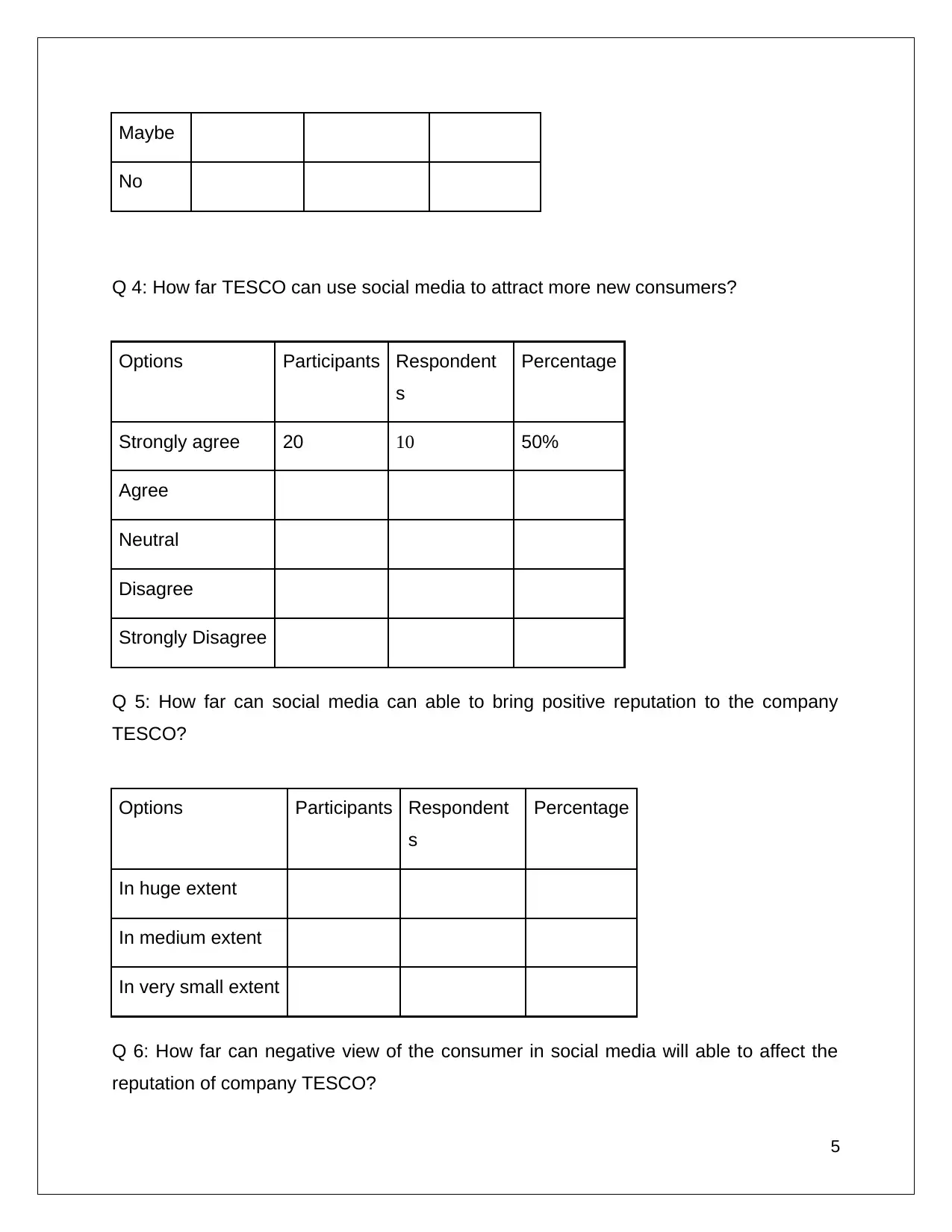
Maybe
No
Q 4: How far TESCO can use social media to attract more new consumers?
Options Participants Respondent
s
Percentage
Strongly agree 20 10 50%
Agree
Neutral
Disagree
Strongly Disagree
Q 5: How far can social media can able to bring positive reputation to the company
TESCO?
Options Participants Respondent
s
Percentage
In huge extent
In medium extent
In very small extent
Q 6: How far can negative view of the consumer in social media will able to affect the
reputation of company TESCO?
5
No
Q 4: How far TESCO can use social media to attract more new consumers?
Options Participants Respondent
s
Percentage
Strongly agree 20 10 50%
Agree
Neutral
Disagree
Strongly Disagree
Q 5: How far can social media can able to bring positive reputation to the company
TESCO?
Options Participants Respondent
s
Percentage
In huge extent
In medium extent
In very small extent
Q 6: How far can negative view of the consumer in social media will able to affect the
reputation of company TESCO?
5

Options Participant
s
Respondents Percentage
Yes
Maybe
No
Q 7: How far TESCO can able to gain strong relationship with consumer using social
media?
Options Participants Respondent
s
Percentage
In satisfactory level
Neutral
In non satisfactory
level
Q 8: Can use of social media will able to bring more awareness of the services and
products of TESCO to the consumers?
Options Participant
s
Respondents Percentage
Yes
Maybe
No
6
s
Respondents Percentage
Yes
Maybe
No
Q 7: How far TESCO can able to gain strong relationship with consumer using social
media?
Options Participants Respondent
s
Percentage
In satisfactory level
Neutral
In non satisfactory
level
Q 8: Can use of social media will able to bring more awareness of the services and
products of TESCO to the consumers?
Options Participant
s
Respondents Percentage
Yes
Maybe
No
6
⊘ This is a preview!⊘
Do you want full access?
Subscribe today to unlock all pages.

Trusted by 1+ million students worldwide
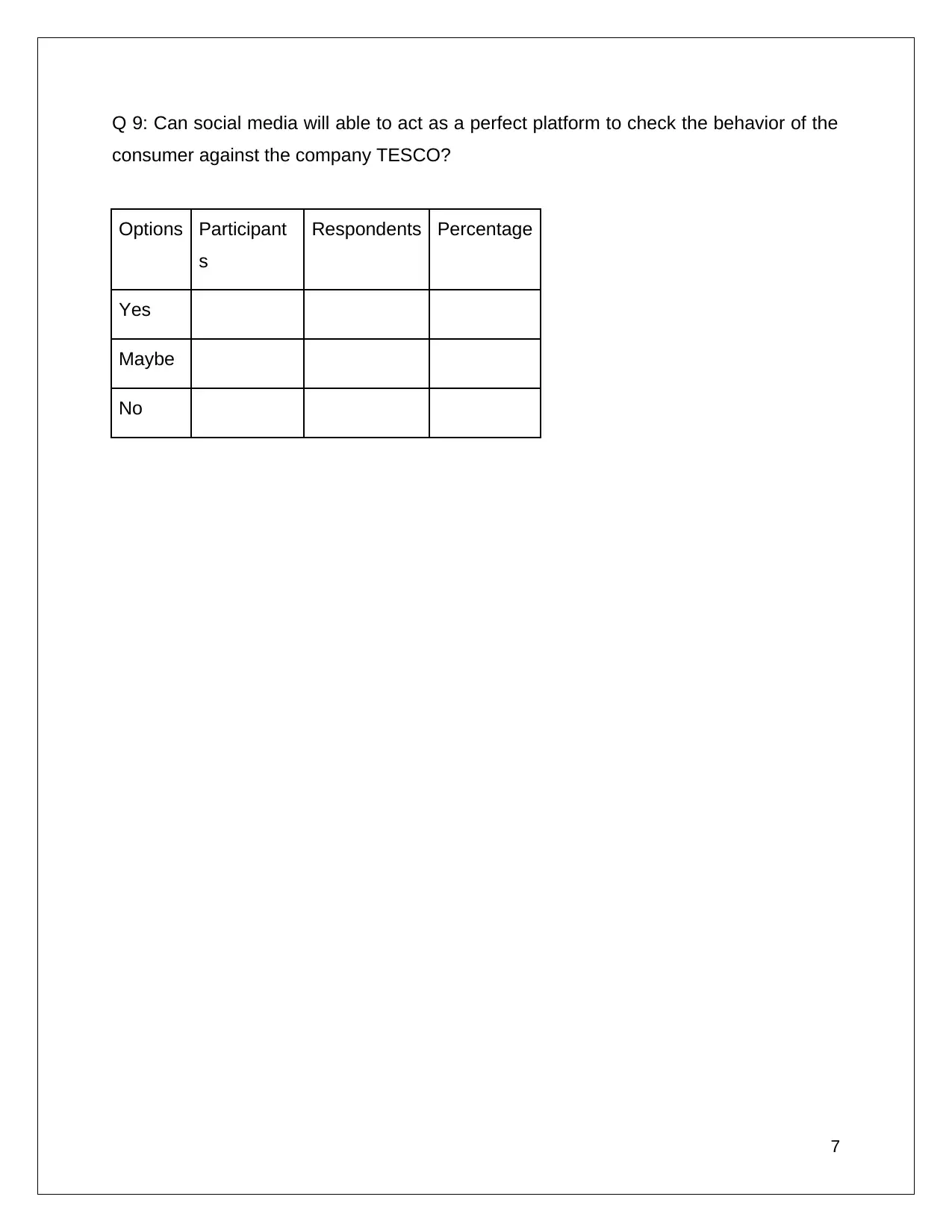
Q 9: Can social media will able to act as a perfect platform to check the behavior of the
consumer against the company TESCO?
Options Participant
s
Respondents Percentage
Yes
Maybe
No
7
consumer against the company TESCO?
Options Participant
s
Respondents Percentage
Yes
Maybe
No
7
1 out of 7
Related Documents
Your All-in-One AI-Powered Toolkit for Academic Success.
+13062052269
info@desklib.com
Available 24*7 on WhatsApp / Email
![[object Object]](/_next/static/media/star-bottom.7253800d.svg)
Unlock your academic potential
Copyright © 2020–2025 A2Z Services. All Rights Reserved. Developed and managed by ZUCOL.




